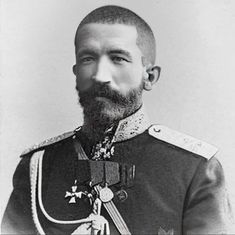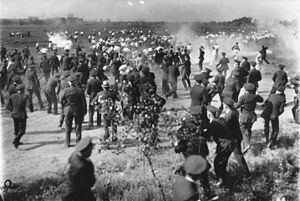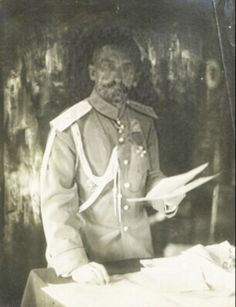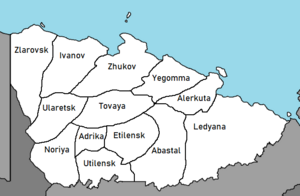Slavic Union
Slavic Union Славянский союз Slavyanskiy Soyuz | |
|---|---|
| Motto: "Potrebnosti naroda prevyshe vsego!" (Russian) "The Needs of the People Above All!" | |
| Anthem: "O dorogaya Slaviya (Russian)" Oh dear Slavia | |
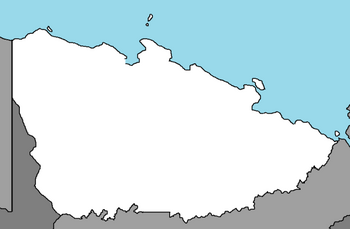 | |
| Capital | Adrikagorod |
| Official languages | |
| Ethnic groups | |
| Demonym(s) | Slavic |
| Government | Federal Semi-Presidential Republic |
| Ulyana Agapova | |
| Mikhail Franko | |
• Deputy President | Vacant |
| Legislature | National Assembly |
| Senate | |
| Chamber of Deputies | |
| Establishment | |
| April 12 518 | |
| October 23 1940 | |
| August 28-31 2021 | |
• Ratification of the Slavic Constitution | September 4 2021 |
| Area | |
• | 2,583,404 sq mi (6,690,990 km2) |
| Population | |
• 2020 estimate | 78,277,000 |
• Density | 30.3/sq mi (11.7/km2) |
| GDP (PPP) | 2021 estimate |
• Total | 1.8 trillion |
• Per capita | 23,651 |
| Gini (2018) | 48 high |
| HDI (2019) | .781 high |
| Currency | Ruble |
| Driving side | Right |
| Calling code | +327 |
The Slavic Union (Slavic: Славянский союз, Slavyanskiy Soyuz) also commonly known as simply The Union is a nation located on the continent of Euronia in the Coalition of Crown Albatross, bordered by Gladysynthia, and Paraboca.
The nation's capital is located in Adrikagorod, with other major cities in Ivanovgorod, Khizny and Zhukovgrad. The nations west is heavily populated, with the majority of the east's population in the Ledanaya region living in small towns.
For centuries the Slavic Union was a series of small, constantly warring princedoms, until they were united into the Slavic Union in 518 in order to defend against the Gladysynthian kingdoms west of the Slavic lands. The Slavic Civil War would directly lead to Field Marshall Nikifor Osipov abolishing the position of imperator and making himzelf Vozhd. In 2021 the August Revolution (Slavic Union) would overthrow the Slavic government and establish a republic.
History
Early History
The first settler of the modern day Slavic Union came during Second Great Iearth Migration dated to approximately 50,000-40,000 years BP. The first settlers came from Zamastan and were primarily hunter gatherers. The mountains near the middle of the country meant that settlement of the east was sparse.
For centuries the lands the now make up the Slavic Union were ruled by warring princedoms until the 500s where the Gladysynthian kingdoms attempted to conquer the princedoms, leading them to sign The Document of Unity, which united the princedoms into a confederation under Imperator Borislav I. The confederation allowed the princedoms to beat back the Gladysynthian kingdoms, and a national identity would begin to form.
Slavic Union
In 587 after decades of constant warfare the Gladysynthian kingdoms would lead one final decisive offensive deep into the Slavic country side, cities were burnt and pillaged, but in 597, as they attempted to cross the mountains of Ledyanaya to reach Roksa and secure victory, winter set in. Thousands were trapped in the mountains, and it is said in Slavic legend that only 100 survived, with Gladsynthia temporarily crippled construction of The Imperators Line began, a massive wall of forts stretching across the Slavic-Gladsynthian border which stand to this day, considered on of the greatest wonders of the world.
In 673 Imperator Adrika I founded the city of Adrikagorod, making it the capital of the Slavic Union.
In the late 700s Imperator Berislav II went on a massive campaign of conquest, subduing many of the tribes of Ledyanaya and pushing south into modern day Khizny.
Christianity would come to the Slavic Union in the 10th century, with Slavic Paganism dying out by the 13th century, though it has seen a recent surge in popularity.
The Imperator Line would be expanded over the centuries, allowing the Union to remain in relative isolation, this isolation lead them to fall behind, and by the 1700s the Imperator Line could do nothing against the weapons of the this new world. In 1742 the Gladsynthian Empire demanded that the Slavic Union cede massive amounts of land, which added up to 10% of it's total landmass and 20% of it's population. The Union refused with Imperator Ivan VIII said to have spit on the paper the demands were written on.
The Gladsynthian empire promptly marched into the Slavic border town of Odizov, General Sandvik Fowler was apparently so confident that the Union would surrender in the face of the Gladsynthian army that he rode his horse into the town square to give a speech welcoming the townspeople into the empire. He would be shot just 5 words into said speech, and the army would be ran out of town by an angry mob.
By the time Gladsynthia returned they would be met with the Slavic army, deciding it wasn't worth it Gladsynthia retracted their demands. This brought a massive wave of nationalist sentiment, with the princedoms that ruled over the regions of the Union slowly losing power.
The 1890 Slavic Revolt lead to major reforms across the Union, the most notable of which being the establisment of the Duma and the abolition of serfdom, which came far after any other nation.
In the late 19th century as technology advanced it was discovered that the originally near inhospitable Ledanaya region held bountiful natural resources, this brought the attention of the Parabocan Empire, which had started struggling since it's loss in the Parabocan war. The leaders of Paraboca believed that a successful attack against the Slavic Union would save the empire from destruction.
Ledyanaya War
On June 21 1901 the Parabocan army invaded the Slavic Union, with the south quickly being overrun and the city of Khizny would be taken. But as Paraboca marched north the famously frigid Slavic winter set in. With Parabocan and Slavic forces digging trench systems along the front lines.
Little progress was made by either side, though the Imperator Line was modernized to defend against Paraboca. In June 1902 the weather was good enough to advance but the trenches made it practically impossible to advance. Trench warfare was a brutal game of attack after attack just to gain a little bit of land.
In early 1903, the heavily outmatched Slavic military finally broke, with it's line shattering and the Parabocan army making a rapid advance towards the city of Adrikagorod, the Battle of Adrikagorod would last 3 months with heavy casualties on both sides, eventually the Parabocan army would be forced to retreat.
The Slavic army managed to strengthen defenses while Paraboca recovered, and eventually it was virtually impossible for Paraboca to push any further north into the Union. In 1907, with Paraboca needing a victory quickly if they wanted to keep things on the homefront from collapsing into chaos they launched the Phoenix Offensive, where an army of 100,000 would go around Slavic defenses through through Ledanaya.
Parabocan high command heavily overestimated their ability to navigate the mountainous and icy terrain of Lenadaya, they also didn't account for the Okhotnik, special forces units made of natives of the Ledanaya region, specially trained in guerilla tactics. Tales of the Okhotnik quickly spread through the ranks of the Parabocan, causing hits to morale, there were exaggerated stories of them eating human flesh and removing organs. This caused thousands to desert, terrified of the okhotnik.
Parabocan forces were severely weakened, and by the time they reached Noyalensk they had no choice but to surrender. The war would officially end on on September 22 1908 with the signing of the Treaty of Khizny, forcing Paraboca to pay massive reparations and eventually causing their collapse in 1910.
This was ultimately a pyrrhic victory for the Slavic Union, with effects from the war causing the economy to crash in 1909, and massive turmoil arrising from this
In 1909 the Slavic Social Democratic Party, better known as the Krasnyy (Slavic for red after the red arm bands they wore at rallies) was formed, and quickly became the dominant socialist party in the Union under the leadership of Arseni Bolotin.
Slavic Civil War
Main Article: Slavic Civil War
On September 12 1917 Slavic police opened fire on peacefully protesting Krasnyy members, starting a riot which lead to the deaths of 9 Krasnyy and 2 police officers, with several more injuries. After this Imperator Aleksei II declared the Krasnyy a terrorist group, which lead to hundreds of Krasnyy taking up arms and storming the capital building in the Battle of the Winter Palace, where Aleksei and his family were rounded up and executed via firing squad before being hung by lampposts in the city streets.
With the Krasnyy quickly taking control of the Slavic capital of Ivanovgorod (The name of which would soon be changed to Bolotingrad) and establishing the Slavic Socialist Republic (SSR) in the nations north, with a provisional Slavic State made up of a coalition of anti-communist forces being established in the south with the capital in Adrikagorod.
Aleksei II's uncle Aleksandr I managed to flee south to Adrikagorod, being installed as a constitutional monarch, his powers now kept in check by the Duma and the Prime Minister. Fighting was almost immediately fierce, Slavic tactics had evolved little beyond close quarters take no prisoners combat, which was effective at striking fear into your enemies, but not at limiting casualties.
One of the few exceptions to this rule was General Nikifor Osipov, who developed a military doctrine known as Sekretvoyna, which would use guerilla and deception tactics, the most prominent use of which was in the Ledyanaya Offensive. Osipov also formed the Slavic Union Party in 1918, a Slavic nationalist party, which soon would become much more.
While Osipov would win victory after victory in the east the rest of the slavic army struggled against the SSR, which controlled Bolotingrad, at the time the industrial and economic hub of the Slavic nation, one of the most destructive examples of incompetence was the Battle of Provropol, in which an underequipped force of 90,000 marched into the city of Provropol, the poorly commanded force would suffer 20,000 casualties, with thousands more captured.

By 1922 SSR forces were within sight of Adrikagorod, with Nikifor Osipov given the task of defending against the 300,000 man strong army with 180,000 men. The SSR was eventually able to capture the city after a nearly 2 year siege where they lost 170,00 men to the Slavic State's 30,000. Osipov was captured by the red army but the SSR was severely weakened to the point where they could never recover.
Osipov was imprisoned by the SSR, and in the time between then and the liberation of the city he wrote The Power of the United Nation, which would become the defining writing of Osipovism, also known as unitism. Osipov published the book once freed from prison in January of 1925, which was an immediate hit, incredibly popular among the masses.
By 1928 the SSR was on their backfoot, and Osipov, now the commander in chief of the Slavic military, planned the killing blow in the Ledyanaya Offensive, Army A, a 150,000 man strong decoy force marched north into SSR territory, while Army B, 80,000 men went through the Ledyanaya region, which the SSR believed to be impassible by a force so large.
In July 1928 the SSR sent the bulk of their army to face head on Army A, meanwhile Army B went around enemy lines and captured the city of Noyalensk, giving them control of the strategically important Noya river, with this tens of thousands of SSR troops were captured. And in 1929 Bolotingrad would be captured, and Arseni Bolotin would be executed along with various SSR leaders.
Slavic State
in 1929 with an anti-communist victory in the Slavic Civil War the Slavic State was unified once again. But things still weren't well, the economy was in complete shambles due to foreign debt accrued from purchasing foreign weapons and the costs of rebuilding after such a devastating conflict, inflation increased massively.
In 1929, just months after the end of the civil war Nikifor Osipov formed the Slavic Union Party (PSS). Nikifor Osipov was incredibly popular, being made Minister of Defense and Commander in Chief of the Slavic army. The Slavic communist movement was crippled, it's leaders had been executed and many had abandoned the ideology after their brutal defeat in the civil war, despite this their was a small communist movement and communists would often battle members of the PSS in the streets of cities.
In 1933 the unrest culminated in the Slavic General Strike, originally a strike of railroad workers it sparked into something much greater after the Osipovgrad Massacre, when Osipovgrad police opened fire on striking workers, killing 32 and injuring 17. Unions across all trades went on strike in solidarity with the railroad workers, further crippling an already weak economy.
On June 15 1933 Nikifor Osipov requested Aleksandr II appoint Prime Minister of the Slavic state, Aleksandr refused, fearing Osipov's popularity. Osipov came back the next day with 10,000 men and his request was then granted. Osipov quickly consolidated as much power as he could and crushed strikes.
By 1934 stability had returned to the Slavic state for the first time in decades, but Osipov was not done, he began instituting his New Unity policies, the institution of which would be the basis for all Osipovist politicians for the future. Osipov increased corporate cooperation with the state and introduced several public works projects, the most notable of which being the Vozhd line, a defensive line on the Slavic border, essentially turning the nation into a giant impenetrable fortress, Osipov also massively ramped up military production in the pursuit of armed neutrality.
Aleksandr II would pass away from pneumonia on October 13 1940, Osipov soon put out a warrant for his childrens arrest, alleging that they planned to overthrow him and establish the imperator as the supreme power, these allegations are widely doubted by historians and are seen as simply an attempt to get the imperator out of the way.
Aleksandr's children would end up fleeing across the border, eventually settling in Drambenburg, where the royal family remains to this day. On October 23 Osipov would declare himself 'Vozhd of all Slavs' establishing the Slavic Union, officially abolishing the monarchy, and writing the Slavic Constitution, also known as the Vozhd Law it is meant to be binding to all Slavs no matter their current nationality.
For the next few years republicans, monarchists, and communists, and various anti-Osipov forces would fight against Osipov's regime in the Slavic Insurgency.
Slavic Union
Osipov further consolidated his power in the state, making the PSS the only legal party within the nation. While anyone outside the Union would've seen Osipov as a dangerous tyrant he had near universal support among the people of the Union, who viewed him as the hero who won the Slavic Civil War and once again saved the nation from chaos in 1933.
World War
The Union maintained an armed neutrality, as it would through most conflicts, during the World War it's borders were heavily fortified and constantly patrolled in preparation for an attack by either side. This military build up lead to a revitalized arms industry, further establishing the Military-Industrial Complex within the Union.
Upon the outbreak of the war there was massive support among the population for intervention in the conflict, despite this Osipov was hesitant due to the Union having still not fully recovered from the civil war despite the conflict having ended 20 years earlier.
In Fall of 1949, with Nikifor Osipov receiving massive pressure to join the war he manages to compromise with interventionists in the nation by signing the Slavic-Drambenburg Aid Treaty, temporarily satisfying the interventionists. The treaty involved the Union suspending trade with the Allied Forces and sending food, ammunition, and equipment to the League Powers, in exchange Drambenburg promised to give the S.U. Gladysinthian land if they won the conflict.
In 1951 Slavic General Iosif Trufanov was planning to march his troops across the border with Gladysynthia and force the S.U. into the war, the Trufanov Plot would be discovered by the DOB and Trufanov would be hung for treason on August 28 1951,
Nikifor Osipov would pass away from a heart attack on April 18 1953, having turned 63 18 days earlier. This event triggered a national week of mourning, he would receive a state funeral with military honors on April 22 1953, with thousands of Slavs attending. The selection of the new Vozhd was not easy, Osipov had held the nation together through his cult of personality and with him now dead unrest within the nation was rising, in addition the Duma was split between Interventionists and Isolationists. Though the Interventionist movement had taken a hit with the Liberation of Vulkaria in April of the previous year they were still prevalent enough to keep Isolationist candidate Khodiak Zhukov from receiving the 350 votes required to secure the position of Vozhd.
Ultimately the Liberation of Jerku would kill the Interventionist movement, and Zhukov was elected as the second Vozhd of the Slavic Union, he would begin efforts to renegotiate the Slavic-Drambenburg Aid Treaty soon after, though he was ultimately unsuccessful.
Over the next 30 years the Slavic Union would continue to industrialize, eventually catching up technologically with the rest of the world.
1971 Slavic Economic Crash
In 1971, under the leadership of Kolzak Nikolaev the Slavic Union suffered through the worst economic crisis since the 1920s, with unemployment and inflation skyrocketing. In 1972 General Vasili Osipov, son of Nikifor Osipov, would have Nikolaev arrested for treason, the government would crack down on monopolies and temporarily would take much greater control of the economy. Eventually in 1976 the economy would return to normal levels.
Under Vasily Osipov the Slavic Union would maintain armed neutrality and complete isolationism, staying out of foreign affairs, foreign trade,and any world event that didn't have a direct effect on them. Vasily would step down in 1998, and would be replaced with Grigori Sokolo, who in 2002 would join the Coalition of Crown Albatross.
Sokolo would resign in 2009 and be replaced with Maksim Borosov, he would resign and be replaced in 2021 with Matvei Pavlov. Just a few months after becoming Vozhd riots would begin across the Slavic Union in response to the army opening fire on peaceful protestors.
These riots, known as the August Revolution (Slavic Union), quickly caused the country to devolve into chaos. On August 30, 2021 Pavlov would be executed by a mob after his forced resignation. The Slavic Constitution would be ratified a few days later, bringing democracy to the country.
Republic
On October 11, 2021 Ulyana Agapova was elected the first President of the Slavic Union, two days later she appointed Mikhail Franko as Prime Minister of the Slavic Union.
Geography and Climate
The Slavic Union is notorious for it's inhospitable winters, especially in the countries eastern region, known as Ledanaya, which is divided from the Slavic Union via the Ledanaya mountains with just the small Ledanaya gap being the only break in the mountain range, as a result the people of Ledanaya have developed a distinct culture from those in the west, with there being a small independence movement in the region.
In the west temperatures often dip below 0 in the winter, with it going even lower in Ledanaya.
In the north the Slavic Union is linked to the Northern Sea, there are numerous fishing villages along the coast. In the late 19th century oil was found in Ledanaya, and continues to be exported to this day. The majority of cities are located on the Noya River.
States
The ratification of the Slavic constitution created 13 states, among them are:
Zlarovsk
Ivanov
Ularetsk
Noriya
Adrika
Utilensk
Tovaya
Zhukov
Yegomma
Abastal
Alerkuta
Ledyanaya
Demographics
The Slavic Union is heavily urbanized, with 78% of it's population living in cities.
The Ledanayan people to the east are often seen as distinct enough to warrant their own ethnic group but they are counted as Slavs by the census agency, and as of the 2020 census the Slavic Union has a population of 78,277,000
Language
The state language is Slavic, which evolved from the original language of the natives. Slavic is typically written using the Cyrillic script.
Religion
Until 2021 the official religion of the Slavic Union was Orthodox Christianity, but after the August Revolution there was no longer an official state religion. The 2020 census states that about 88.2% belong to the Slavic Orthodox Church, 6.5% are Catholic, .6% are Atheist, .6% are Muslim, and 2.1% are Pagan.
Government
The Slavic Union is a semi-presidential republic, the first round of the presidential election is to be held October 4th, the top two candidates then face off the next week in the second round of the election. The President appoints a Prime Minister who selects the Presidents cabinet and oversees Senate meetings. The Chamber of Deputies is overseen by the Deputy President, who is elected by the Chamber of Deputies, and is second in line for the presidency if the incumbent president resigns, is removed from office, or is generally unable to continue his duties. The President serves 4 year terms, with a 2 term limit.
National Assembly
The Slavic Senate is made up of 75 senators elected by proportional representation, and acts as the upper house of the National Assembly. The Chamber of Deputies is the lower house of the Assembly is made up of 250 Deputies.
Cabinet
Ministers
| Office (Constituting instrument) |
Incumbent | Took office | Party |
|---|---|---|---|
| Federal Minister of the Interior | October 16, 2021 | Stepan Serpionov | Slavic Labor League |
| Federal Minister of Foreign Affairs | October 16, 2021 | Luiza Zaslavskaya | Green Union |
| Federal Minister of Defense | October 17, 2021 | Pota Guslyakov | Slavic Labor League |
| Federal Minister of Economy | October 15, 2021 | Gertruda Rusakova | Slavic Labor League |
| Federal Minister of Education | October 19, 2021 | Agafon Kalganov | Green Union |
| Federal Minister of Justice | October 15, 2021 | Andrei Kolupayev | Green Union |
| Federal Minister of Infastructure | October 15, 2021 | Yuliy Tarnovetsky | Slavic Labor League |
| Federal Minister of Agriculture and Environment | October 18, 2021 | Bugomil Subotin | Green Union |
| Federal Minister of Labor | October 17, 2021 | Bugomil Subotin | Slavic Labor League |
| Ambassador to the CCA | October 19, 2021 | Afanasy Azhikelyamov | Slavic Labor League |
Law Enforcement and Crime
Foreign Relations and Military
Economy
Culture
The Slavic people are incredibly proud of it's culture, being incredibly nationalist. Slavic art is typically very dark and sorrowful, representing the often poor living conditions of the Slavic people, though the tone depends to change with the more nationalist art.
Slavic media is heavily controlled by the government, with only state approved content being allowed on tv, news and the internet. With any new art also requires state aproval, with only Slavic art allowed to be displayed in museums.
Sports
Soccer is the most popular sport in the Slavic Union, the top soccer league in the Union is the Slavic Premier League, basketball is second, with it's top league being the National Basketball Union







